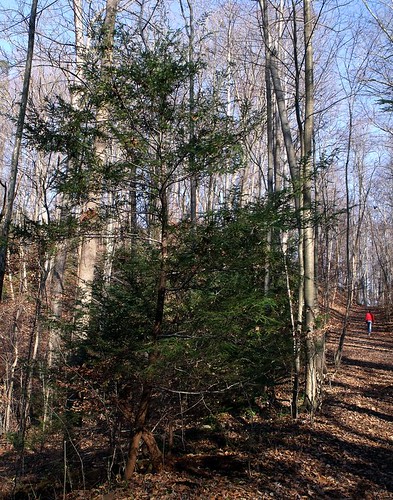
Eastern Hemlock (Tsuga canadensis) is a majestic tree sometimes called the "redwood of the East." They can form tranquil evergreen groves in the understory, but really, they're just waiting for their big break. When a tree falls and opens a spot in the canopy, hemlocks will shoot up -- eventually reaching heights of 80 or even 100 feet over their 350 year lifespan. In the second-growth forests of the DC area, though, you'll see only scattered trees, and they're rarely taller than 15 or 20 feet tall.
Because they're evergreen, this is a great time of year to look for hemlocks, when other trees have lost their leaves. The needles of hemlock will help you distinguish this tree from other evergreens in our area: they are flat, about 3/4 of an inch long, and grow in a plane off the twigs. The overall form of hemlocks can also be distinctive: branches grow horizontally from the trunk, but are floppy on the ends as the twigs haven't hardened up yet. Up close, you may notice very small cones on the trees -- they look like pine cones, but much smaller.
The genus name, Tsuga, is a Japanese word supposedly meaning "mother tree." Unfortunately the relationship between North American and Japanese hemlocks is not so nurturing. Around 1911, some imported hemlocks bound for a Japanese garden in Richmond came bearing an insect known as the hemlock woolly adelgid (uh-DELL-jid). This relative of the aphid is just a minor pest in Japan, where it's got several predators and the trees have some natural resistance. For our local Tsuga canadensis, though, infestation by the woolly adelgid is usually fatal within 4 to 10 years.
It wasn't until the 1980's that people started noticing that the adelgid had spread from ornamental plantings in Richmond to native trees in York River State Park and Shenandoah National Park. By the mid-90's, the adelgid had spread to Connecticut and Massachusetts, and it is now considered established throughout the hemlock's eastern range, from Maine to Alabama. Experiments are being done with the release of adelgid-eating beetles from Japan, but results don't seem very promising, and many stands of hemlock have already been lost. (To see some of the destruction to old growth hemlock groves, see this video from the Charlotte Observer.)
 There are two morals to this story. First, garden with native plants, so that you don't unwittingly import a pest that will devastate an entire species. Second, get out there and appreciate what we've got, while you can.
There are two morals to this story. First, garden with native plants, so that you don't unwittingly import a pest that will devastate an entire species. Second, get out there and appreciate what we've got, while you can. In the wild: We're not aware of any really large hemlocks in the DC area (do let us know!) but there are still some small hemlocks scattered in our local forests. The most we've noticed are at Scott's Run Nature Preserve in McLean -- they grow right along several of the trails there (like the one shown here).
In your yard: It's probably better not to bother planting hemlocks unless and until someone figures out how to control the adelgids. Too bad, because they're beautiful trees.
Like the photos in this post? Mouse over for credits; a click takes you to the photographer on Flickr.



